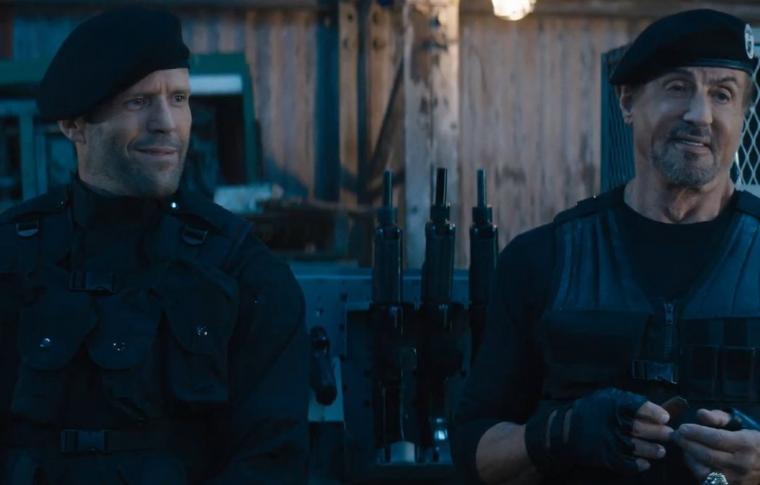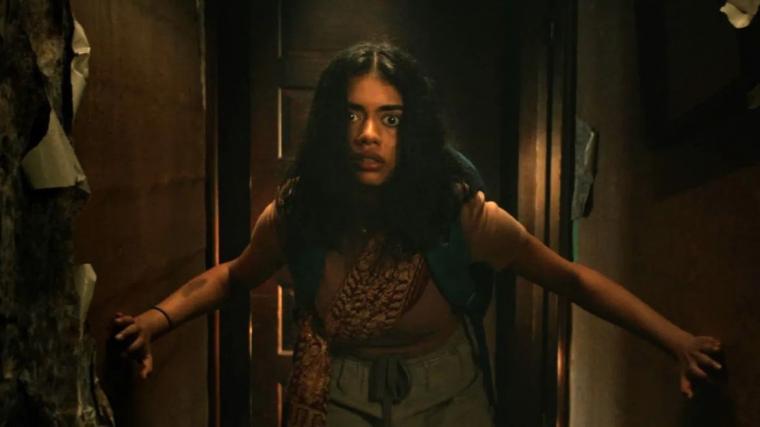
Jason Statham and Sylvester Stallone in Expend4bles
EXPEND4BLES
Because the competition is so fierce, it's hard to say which scene in director Scott Waugh's action sequel Expend4bles is the most repellent. And for the sake of time and our collective sanity, I'm going to ignore every multitudinous instance of brains being splattered via gunfire, the effects for which look like they were added post-production with a red magic marker.
Maybe it was the introduction of Megan Fox, looking Botox-ed to the point of immobility, who hurled breakable objects and screeched at top volume at boyfriend Jason Statham for no disclosed reason while he and Sylvester Stallone traded glances and quips that effectively read as “Hmph – women.” Or perhaps it was the bit that found Dolph Lundgren, whose Expendable was proudly sober after years of drunkenness, deciding to eff it and take a healthy slug of booze from his flask – a moment designed to make us cheer rather than wonder if his sponsor could be alerted. I suppose it could've been former UFC champ Randy Couture explaining to an agog onlooker – which he does more than once – what the deal was with his Expendable's distracting cauliflower ears; or one of new recruit Jacob Scipio's frequent, meaningless recounts of his icky sexual history; or the reveal of this followup's official turncoat, which is nearly as unsurprising as the revelation of Matthew Modine's treachery in August's Liam Neeson vehicle Retribution. (Please don't Spoiler Police me: That “twist” was evident from the moment Modine was cast.)
But if forced to name a low point among the many, many lows of Expend4bles, I'd have to go with a two-pronged attack. First, I'd cite Statham and Stallone beating the bloody pulp out of an entire bar's worth of hoodlums for the insult of one of them, a diminutive bruiser “hilariously” named Jumbo Shrimp, besting Stallone's Barney Ross in a thumb-wrestling contest – a fight that Ross grudgingly admits the dude won fairly. But that's not the worst that poor little Jumbo Shrimp suffers, because with mere minutes to go in this astoundingly asinine film, we find out what happened to the guy after he was senselessly pummeled in a skeevy New Orleans bar. It turns out that while the man was unconscious, Jumbo was strapped to the pilot's seat of a plane by one of our protagonists – again, for the crime of winning a thumb-wrestling competition fairly – and, upon his awakening, forced to witness his own demise in a hideous explosion. The teller of this morbid tale laughs and laughs, as does his listener. Then the end credits roll. Meanwhile, the few sane viewers among us are left to wonder if we really just witnessed a $100-million-budgeted entertainment whose purported heroes were hatefully irredeemable, staggeringly unamusing psychopaths. Waugh's movie didn't need a script supervisor. It needed an exorcist.
I'm thrilled to report that loads of potential audiences (in the U.S., at any rate) could clearly smell crap when it inched up on them, and during its debut weekend, Expend4bles barely made $8 million domestic – not even enough to unseat the third weekend of The Nun II, which also isn't any great shakes in the sequel department. So bully for discerning filmgoers, I guess. The question remains as to why Lionsgate would plunk a reported tenth-of-a-billion into a franchise that most of us hoped had died a merciful death with 2014's The Expendables 3, back when Stallone still hadn't brought Rocky Balboa back for the Creeds and was five years away from yet another Rambo. Wasn't there any other Stallone hero, beyond über-violent mercenary Barney Ross, that our beloved National Meathead might've resurrected instead? Judge Dredd? His vocally challenged NYC cabbie from Rhinestone? Hell, I would've even welcomed a reprise of whatever role Sly played in his notorious 1970 soft-core porno The Party at Kitty & Stud's – unimaginatively renamed The Italian Stallion during the VHS era – if it meant less time spent with Barney and his interchangeable ass-kickers. Worse still, and yet again, Stallone is dragging Statham down with him, and no movie star alive currently looks more unhappily bound by an invisible straightjacket.

A glass-half-full response to Statham's participation here would be that he at least looks to be having more fun than in this summer's Meg 2: The Trench, in which he pulled off the miraculous feat of a two-hour grimace. Our stubbly he-man is obviously aware that his punchlines as Expend4bles' sociopath Lee Christmas are so lame as to require a walker. Yet every so often, Statham still manages to unleash one of his wonderfully gummy grins and momentarily convince you that he's having a high ol' time. (I won't speculate on whether the star was actually high, which could only have helped in getting through this nonsense.) Those smiles still reek of desperation, to say nothing of depression.
The Expendables series, which originated in the relatively halcyon days of 2010, was always intended as a violently ridiculous (and vice versa) pastiche of '80s-flick action clichés, and what made them bearable – and in 2012's Expendables 2, semi-enjoyable – was the self-aware delight that genre notables Stallone, Lundgren, Arnold Schwarzenegger, Bruce Willis, Harrison Ford, Mel Gibson, Chuck Norris, Jean-Claude Van Damme, and others brought to them. But this series has been shedding icons for a while now – even Stallone is only around for about 20 minutes of Expend4bles – and you can practically read the morose acceptance on Statham's face in this fourth installment, recognizing that he's the new genre dinosaur du jour. This makes it almost poetically just that Statham gives the only thing resembling a decent, thought-out performance, with some co-stars (Stallone, Fox, Couture, Andy Garcia, Curtis “50 Cent” Jackson) either coasting on personality or lack thereof, and the readings of others (Lundgren, Tony Jaa, Iko Uwais) suggesting that English wasn't their second language, but perhaps their fifth or sixth.
Oh, right: the plot! It's about our mindlessly brutal task force having to defeat a nefarious mastermind who steals nuclear warheads from Muammar Gaddafi's former chemical-weapons plant in order to fight World War III against the Russians. I wouldn't have been shocked had it involved the purloining of a floppy disk while Duran Duran tunes littered the soundtrack and Dolph Lundgren played Ms. Pac-Man. Yet the cheering effects of nostalgia only last so long. Expend4bles – which my phone's Google voice translator adorably calls “Expend for Bless” – is stupid, boring, and insulting enough to force we Gen X-ers into accepting that the '80s-movie landscape we frequently fetishize was largely atrocious. Sorry: 4trocious.

DUMB MONEY
It's always fun to see the development of connecting themes over a year in movies, and it seems safe to say that 2023 has thus far been the year of “How Stuff Happened.” How was the atomic bomb created? Where did Nike's inspiration for Air Jordans come from? What initiated the invention, and ultimate demise, of the BlackBerry? Why would anyone make and market a Cheeto the color of a stop sign? (I haven't yet made time for the Frito-Lay origin story Flamin' Hot, but Oppenheimer, Air, and BlackBerry are all terrifically entertaining as well as educational.) Now we have director Craig Gillespie's Dumb Money, which, in a speedy 104 minutes, explores the origin and history of 2021's headline-grabbing spike in GameStop shares. All told, it's an excellent film: informative, funny, lightly poignant, and continually gripping, despite the final scenes being a tad too Pollyanna for comfort. But although it's a first-rate “How Stuff Happened” offering, Gillespie's thoughtful comedy might be an even finer period piece – if, that is, 30 months ago is far-enough away to qualify as “period.”
In a role that's a far better fit for him than the character of Spielberg's dad was in last fall's The Fabelmans, Paul Dano is unfailingly endearing as Keith Gill, the financial analyst and frequent YouTuber (under the alias Roaring Kitty) and Reddit poster (as DeepF---ingValue) whose incisive understanding of the stock market led to him seeing the value in the GameStop retailer when no one else did. Gill's smarts and ingratiating enthusiasm resulted in his gathering a small, and then huge, army of acolytes who similarly invested in GameStop and drove the share prices up – way up, as stock that was initially selling at $3.85 eventually rose to nearly $350 per share. This was very bad news for the Wall Street 1-percenters (personified here by Seth Rogen, Vincent D'Onofrio, and Nick Offerman) who were getting crazy-rich by short-selling GameStop stock. Yet it was also thrilling, potentially life-altering news for the debt-ridden non-elites (represented by America Ferrera, Anthony Ramos, Myha-la Herrold, and Talia Ryder) who, thanks to Gill's wise tip and undying passion, were starting to see earnings they never dreamed of. If Frank Capra had access to Internet memes, TikTok videos, and Pete Davidson hurling comedic expletives, the results would look a lot like Dumb Money, a thoroughly delightful little-guys-v.-The-System crowd-pleaser that's like a high-tech Mr. Smith Goes to Washington – or The Big Short without condescension or Margot Robbie in a bathtub.

The ending, as previously suggested, is somewhat underwhelming, as it misleadingly implies that lifelong changes in market tactics was initiated by Gill's actions. (Short-selling may have momentarily slowed down over the past two years, but you can be sure the practice didn't end.) There's also very little demonstration of the movement's fundamental pyramid-scheme nature; the only stock buyers we see are ones who came in on the ground floor and were destined to make more money than those arriving late to the party. These, however, are minor complains in the face of all the fun Gillespie's movie delivers. With Lauren Schuker Blum's and Rebecca Angelo's sharp, coherent script sensationally well-performed (the stacked cast also features Shailene Woodley, Sebastian Stan, Rushi Kota, Dane DeHaan, Kate Burton, Clancy Brown, and Olivia Thirlby), and Gillespie providing an enticing docudrama flavor much the way he did in I, Tonya – the clever editing making it appear as though Alexandria Ocasio-Corez is actually interrogating Sebastian Stan – the film boasts immediacy and real-world sting. Yet the giddy, present-day jolt of it all also feels incredibly distant, given that no non-documentary I've yet seen has delivered Dumb Money's unmistakable sensation of living in America in the first months of 2021.
Back when face masks were mandatory, I mistakenly presumed that contemporary movies would naturally have to start incorporating them into their narratives. How, for instance, could you present a modern-day rom-com in, say, Manhattan without addressing the issue? (And by the way, wouldn't it have been a kick to see filmmakers try? If eventual lovers enjoying a Meet Cute on the sidewalk had to be enchanted by something other than a winning smile?) But aside from rare, generally tangential appearances in Drive My Car and other works, masks were nowhere to be found. Dumb Money more than makes up for their absence.
Between the scenes of wholly masked commuter transit, the ultra-rich steadfastly refusing to cover their mouth and nose while their servants' faces are half-hidden in fabric, college kids brazenly enjoying make-out parties, and certain self-righteous types turning the issue into an opportunity for belittlement – DeHaan's GameStop store manager forces Ramos' employee to mask up when the two are the only ones in their store, and standing 20 feet away from one another – it's early-'21 like mad in Gillespie's film. (The videos, needle drops, and astoundingly dated vernacular also do their fair share in cementing the period.) And while I greatly enjoyed Dumb Money as an educational entertainment, I absolutely adored it as a cinematic snapshot. Given the triggering sights of DoorDash meals, Congressional hearings held via Zoom, and lonely souls longing for human connection even if it means connecting through a collective upending of the stock market – it's telling that none of our empathetic investors ever meet one another, let alone meet Gill – this might not be a snapshot you'll necessarily want to look at often. It's still one that, in all likelihood, you'll be glad exists.

CASSANDRO
As the openly gay Mexican wrestler Saúl Armendáriz in writer/director Roger Ross Williams' sports bio-pic Cassandro (now streaming on Prime Video after a series of well-regarded festival screenings), Gael García Bernal is so heartbreakingly lovely that it barely matters that the film he stars in is formulaic, unsurprising, light on necessary detail, and ultimately unconvincing. Granted, those aren't trivial complaints. But maybe they're forgivable ones considering the unusual arc of Williams' and co-screenwriter David Teague's tale, which isn't, refreshingly, about our protagonist learning to accept his gayness, but about his journey toward making bigoted lucha libre fans accept his gayness. In terms of the coming-out genre, this is definitely a welcome change of pace.
Williams' approach also inspires a truly touching mother-son love story as Saúl and his single mom Yocasta (the spectacular Perla De La Rosa) endure financial hardship, public scrutiny, and routine embarrassment as the tyro makes the brave decision to be something unheard of in the field of Mexican wrestling, or any wrestling in the movie's early-1980s setting: a serene and confident homosexual, as well as a flamboyantly dressed one, who actually wins matches. (Prior to Armendáriz's debut as the unmasked Cassandro – his lack of facial covering already being novel – those who wrestled in drag as exóticos were consistently obligated to lose their competitions in front of cheering, jeering crowds.) I wish I could say precisely how this winds up happening. During one of Cassandro's early matches, a shrewd promoter tells the wrestler's opponents that they'll get double their contracted pay if they intentionally lose, but we never learn whether this practice continues through the whole of Armendáriz's career. The pay structure is never referenced again, and we're given no behind-the-scenes conversations in which the matches' mechanics are worked out in advance. (I'm sure it'll come as a shock, but from what I've gleaned, these things aren't always organically staged.)
In addition, it becomes distressingly easy to predict where the storyline beats will land and in what order, and while it's undeniably heartening to witness a mass of spectators momentarily rid themselves of their prejudices when rooting for Cassandro, I'm not sure the sight makes up for the collectively shouted/subtitled epithets of “Homo!” and worse that accompany our hero's feats in the ring. Still, Williams' film is a sweet, tender work whose heart is unquestionably in the right place, and it grants the eternally youthful and buoyant Bernal perhaps his strongest role to date. I mean that partly literally, as it's evident that the actor is performing many of his stunts himself, and Bernal's moves, while demanding impressive upper- and lower-body strength, are gorgeously lithe and frisky. (You can see why a pro-wrestling fan base reared on obscenely muscular champions would take to Cassandro and his Mexican-Liberace vibe.) Even when his material veers into easy sentiment, though, Bernal remains magical, and he keeps showing different sides of Armendáriz's persona: warm and deferential with his mother; flinty and funny with his manager (Roberta Colindrez); sexually forward and easily wounded with his married lover (Raúl Castillo); initially timid and laudably defiant with his long-absent father (Robert Salas). You could ask for a better movie from Cassandro, but you'd be hard-pressed to wish for a better lead.

IT LIVES INSIDE
Just as Cassandro, to a degree, shakes up the traditional sports-bio-pic genre by giving us a gay protagonist, debuting writer/director Bishal Dutta's It Lives Inside shakes up the imperiled-teen-horror-flick genre not only giving us an Indian-American heroine, but by making her ethnicity a key component in the movie's DNA. I initially scoffed when I saw the film's poster proclaiming it as “from the producer of Get Out,” in part because that's the sort of promotion a studio would reflexively employ when Jordan Peele wasn't remotely involved (the producer alluded to is actually Sean McKittrick), and in part because it seemed a rather insultingly baity way to attract audiences: “This one has a lead of color, too!” But I'm happy to say that, while this PG-13 release isn't particularly scary, it's certainly engaging, and would be of at least moderate interest even if it provided zero frights – and the tally it ultimately amasses is considerably higher than zero.
An intelligent, seemingly popular student who has obviously worked hard to assimilate, Megan Suri's Samidha – she prefers the Americanized “Sam” – is one of only two Indian-American students at her suburban high school, the other being her former best friend Tamira (an impressively ravaged Mohana Krishnan), who has gotten weird lately. Specifically, she's taken to wandering the halls looking desperately sleep-deprived, and carrying a glass jar in which, as she eventually explains to Sam, she carries a hideous demon from Indian folklore who consistently demands red meat and will kill if it isn't fed. Suffice it to say the figurative genie gets out of the bottle, Tamira vanishes to reaches unknown, and Sam finds herself responsible for the flesh-eating Pishach hunting for foodstuff, with all of Sam's nearest and dearest apparently on the menu.

During early stretches of Dutta's film, you might mistake It Lives Inside for a gentle assimilation dramedy, with Sam fighting against the traditionalist ways of her parents (the expert team of Neeru Bajwa and Vik Sahay), pining over a cute Caucasian (Gage Marsh), and enduring the ostensibly well-meaning pandering of her upper-middle-class schoolmates, who obviously pride themselves on being friends with “the Indian girl.” (One of Sam's pals requests that she demonstrate her multi-culturalism by speaking Hindu, forcing the embarrassed Sam to correct her by stating that it's “Hindi” with an “i.”) These sequences are solid, and unfortunately, an improvement on what we get after the movie turns into a more generic fright film, one that too-often indulges in clichés – the “dream within a dream” has officially become as tired as the standard bad dream – and delivers an exhaustingly loud and undernourished finale that transpires in the exact Stranger Things fashion you anticipate.
Yet while much of Dutta's debut transpired in ways I expected, I absolutely didn't expect the experience as a whole to be so … charming? Beyond the de rigueur jump scares, there are a couple of expertly staged instances of genuine fright – one involving the invisible menace (in a first-rate effect) strangling a kid mid-air on a swing set, and another involving a character being systematically terrified by hallway lights not being turned off, but tuned on. It Lives Inside, though, is far more effective when detailing how Sam's cultural dislocation directly influences, and is represented by, the nightmarish goings-on, forcing our heroine to accept her upbringing – and her parents' traditions – as the only way to survive and defeat her supernatural assailant. Sam's Indian heritage isn't a genre twist so much as the film's entire reason for being, and I silently applauded the moxie involved in crafting a disposable genre offering this specific. Plus, in a movie admirably acted across the board, the divine Betty Gabriel, who played the crying-through-grins housekeeper in Jordan Peele's 2017 masterpiece, shows up as Sam's empathetic teacher, and her scene of utter panic – one that seemingly lasts for 20 minutes – is a deserved show-stopper. With all deference to producer Sean McKittrick, promoting Dutta's film with the poster tagline “featuring a co-star of Get Out” alongside an image of Betty Gabriel might've done a finer job of ensuring butts in seats.








